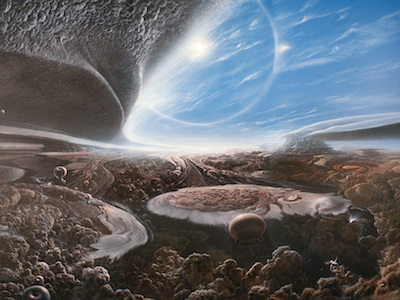Sunday the 18th's episode of Cosmos begins with the flood myth (the Babylonian version featuring Gilgamesh, not the gritty reboot with Noah). Thereafter, Neil deGrasse Tyson takes us to the early Earth, asks how the first life arrived on our planet, and speculates about how life might move between planets and even galaxies. And then he addresses the present and the future with a meditation on how civilizations rise and fall.

Artist Adolph Schaller's conception of life on Jupiter, a painting used in episode 2 of Carl Sagan's Cosmos. The image was inspired by Sagan's speculative writings about extraterrestrial life, portraying a three-dimensional ecology of life floating in Jupiter's gaseous atmosphere. Its style and presentation in the show made it clear where the line between science and speculation lay. The image is © Adolf Schaller, 1980, and used by permission of the artist.
Panspermia, the movement of lifeforms between planets, is certainly not beyond the pale scientifically—no less a figure than Svante Arrhenius proposed it—but is probably the most scientifically fringy idea that’s been presented on the show thus far. And its presentation brings to the fore a concern I’ve had since the first episode. With all the advancements in computer graphics since Carl Sagan’s original Cosmos, how well can viewers really distinguish between images that represent the very best consensus science—images captured by the Hubble space telescope or reconstructed from data gathered in neutrino detectors and supercolliders, for instance—from speculative but stunningly realistic animations that represent one possible interpretation of the available evidence?
In this episode, during a discussion of how we’ve learned about Martian geology, we see a clearly cartoon Egyptian farm community struck by meteorites. Then appears a 3D animation of one of the Viking Mars landers from the ’70s, incredibly realistic, but obviously not filmed (since no one was on Mars to film the landing). And then we cut to Curiosity, the laser-wielding science robot we recently landed on Mars. As Curiosity’s camera pans across the landscape, there is Neil deGrasse Tyson, seemingly standing on Mars.
Viewers can obviously tell that such scenes aren’t literally true, and it’s OK to digitally insert Tyson onto the Martian surface. And it’s OK for him to talk about how terrestrial bacteria could have gone to Mars, or Martian bacteria to Earth, on meteorites. That’s a much more speculative notion, but not implausible. And I’ve been missing that wacky, speculative element of Carl Sagan’s original series, his willingness to take a flier on a wild idea and see where it would go.
But Sagan was careful to script those flights of fancy as exactly that: scientifically informed but as-yet untested notions. The technological limits of his day meant that those speculations were illustrated by flat paintings, which were hard to confuse with reality, while he could back up evidence-based statements by showing the actual paper where the data were first recorded. The show tried, at least, to signal how skeptical the viewer ought to be.
That life may have moved between the planets is surely plausible: modern bacteria can survive outside the International Space Station for extended periods, so we can’t rule out the possibility that early life did the same. And the early Earth was surely under constant bombardment. Yet the first signs of life appear in the earliest rocks where we could hope to detect those signs. So it isn’t unreasonable to think that an orbiting cloud of debris kicked up by early meteorite impacts may have offered a refuge for the first life on Earth. But it may also be that the first life resided in deep vents or other sites unaffected by those impacts, and no evidence of interplanetary movement of life has been found thus far, let alone transfer via comets bearing bacteria from one galaxy to another.
Tyson presents panspermia using the same high quality animation Cosmos uses to present ideas that are as well-demonstrated as anyone could ask. And this is risky. On the one hand, perhaps people will take these speculative ideas to be no less credible than established science. On the other hand, perhaps people will take the established science to be no more credible than these most speculative sections of the show. Either way, the result is not what we want of public expositions of science.
The last section of the show, dealing with civilization-ending disasters, is one that a lot of people will want to dismiss, even though the discussion relies on widely accepted science.
Tyson mentions the risk of a planet-ending supernova, and a supervolcano which erupts and blocks the sun, or an asteroid impact which does the same. He reminds us that the great civilization which gave us our flood myth was destroyed because of a drought that cut off irrigation and left fields too salty to plant. Then he turns to the threats posed by fossil fuels and the climate change their burning causes.
In one respect, we’re ahead of the people of ancient Mesopotamia. Unlike them, we understand what’s happening to our world. For example, we’re pumping greenhouse gases into our atmosphere at a rate not seen on Earth for a million years. And there’s scientific consensus that we’re destabilizing our climate. Yet our civilization seems to trapped in the grip of denial, a kind of paralysis. There’s a disconnect between what we know and what we do.
In part, he blames this disconnect on our tendency for short-term, profit-driven thinking. He urges us to think more deeply, to take full advantage of our intellects, to think about the future and the greater good of society, humanity, and the world we live in. The warning and the prescription are right, and anything that makes it easier for people to dismiss the warning would be truly unfortunate.
Already we see the deniers jumping on that contrast. Casey Luskin, the Discovery Institute shyster who reviews Cosmos for the creationist group, writes complainingly about the section on climate change:
Notice the irony. Tyson rejects the consensus on panspermia (while failing to disclose that fact). Yet he uses the “consensus” on global warming as a club to bully dissenters.
Luskin later asserts that he’s “very open to the possibility that the ‘consensus’ on climate change is correct,” but neither endorses it nor calls out the climate change denial by his colleagues.
The next episode of Cosmos is reportedly all about climate change, so expect even more pushback—and maybe a cameo by Arrhenius, the first scientist to predict that fossil fuel usage would result in global warming—then.

